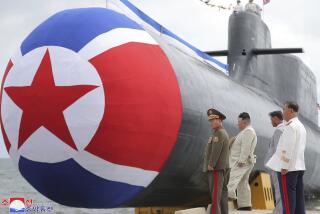Nuclear-Powered Submarine Fuels Controversy Over India’s Intentions
- Share via
NEW DELHI — When Prime Minister Rajiv Gandhi christened the Chakra, India’s first nuclear-powered submarine, early this month he said it was to be used for training and that it would never carry nuclear weapons.
But now the Chakra--the word means “vortex or center of psychic energy”--is at the heart of a controversy over India’s intentions as a nuclear power.
Western military analysts quickly contradicted the Indian navy’s description of the 20-year-old Soviet-built vessel as one of the Victor I class, a torpedo-carrying submarine not equipped to carry missiles.
The analysts said photographs at the christening ceremony show the Chakra to be of the Charlie I class, designed to carry eight cruise missiles as well as torpedoes.
“The Charlie is a missile-firing submarine,” a Western military expert said, pointing to the characteristic Charlie bulge at the Chakra’s bow. “That is a Charlie.”
Arms Escalation Charged
India is the first Asian or developing country to have such a vessel. Acquisition of the Chakra, whose nuclear reactor will be monitored by Soviet technicians, has stirred rival Pakistan and some Westerners to charge that India has escalated the nuclear arms race in South Asia.
“This is a watershed, a qualitative change in the regional military balance,” a Western specialist on military affairs in India and Pakistan said.
Pakistan’s ambassador to India, Humayun Khan, said in an interview: “Even at the (christening) of the submarine, the Indian prime minister proclaimed India’s continuing commitment to the peaceful use of atomic energy. To my mind, nuclear military power is not restricted to nuclear bombs but also includes the use of nuclear energy for other weapons of war.”
Shortly after India got the submarine on a lease from the Soviet Union, the authoritative British publication, Jane’s Defense Weekly, reported that Pakistan had opened talks with a Canadian firm about the possible purchase of submarines propelled partly by nuclear power. This hybrid type, still in the design stage, was proposed for the Canadian navy before Canada decided to buy nuclear submarines from Europe.
Since India exploded a nuclear device in 1974 and Pakistan began its own nuclear weapons development program, the Indian subcontinent has become the setting for one of the most-feared scenarios of the nuclear age--an arms race between Third World countries, at least one of which has a history of political instability.
U.S. Critical of Soviets
The United States has been critical of Moscow’s role. In an appearance Thursday before a House subcommittee on Asian and Pacific affairs, Robert A. Peck, a deputy assistant secretary of state, said:
“We believe the Soviet lease of a nuclear-powered submarine to India is an unfortunate development. Encouraging India, which has been a leading opponent of the Non-Proliferation Treaty, in the military uses of nuclear energy and provision of closely held naval reactor technology to that country would, in our view, undermine the international non-proliferation regime.”
Some Western military experts appear to be less concerned over the Chakra. “India wants to take over the mantle of the British raj,” said one who asked not to be identified by name. “They are building a big, modern navy. It is natural that they would consider nuclear propulsion.”
Some experts said leasing of the Soviet vessel may indicate a setback in India’s own effort to develop a nuclear propulsion system.
Despite its dependence on the Soviet Union for much of its sophisticated weaponry, the Indian military has never before accepted Soviet advisers. The presence of at least two on board the Chakra at all times is said to be galling to some independent-minded Indian naval officers.
Some Western diplomats believe that the submarine leasing and other recent public displays of the Indian-Soviet military connection are intended partly to reassure Moscow that the connection remains firm.
The displays, including advanced MIG fighter planes in India, have come at a time when India has expressed increasing willingness to buy Western military material and technology.
Domestic Political Effect
“Soviet willingness to lease this (submarine) to India probably reflects a desire to maintain their status as India’s principal arms supplier, despite recent Indian efforts to increase domestic arms production capabilities and acquire Western military systems,” Peck told the House subcommittee.
Gandhi’s speech at the vessel’s christening indicated that the Chakra may also have a domestic political impact. The prime minister, without mentioning the U.S. naval facility on the island of Diego Garcia, cited the presence of foreign naval powers in the Indian Ocean.
“As long as threats to our sovereignty and integrity continue,” he said, “India has no option but to take every possible step to safeguard its security. We are ready to undergo any sacrifice for the independence of our motherland.”
Two weeks after the Feb. 3 christening, a national magazine poll showed that Gandhi’s popularity, which had suffered under attack from dissidents within his party, had risen by more than 10 percentage points.
More to Read
Sign up for Essential California
The most important California stories and recommendations in your inbox every morning.
You may occasionally receive promotional content from the Los Angeles Times.












